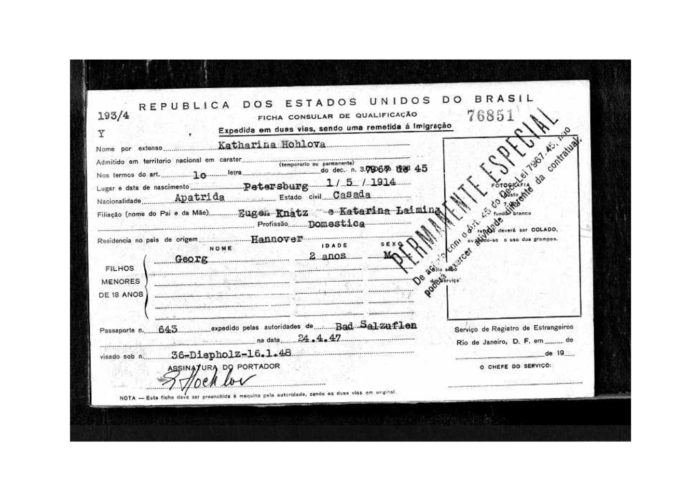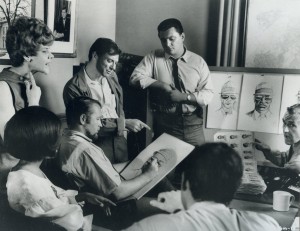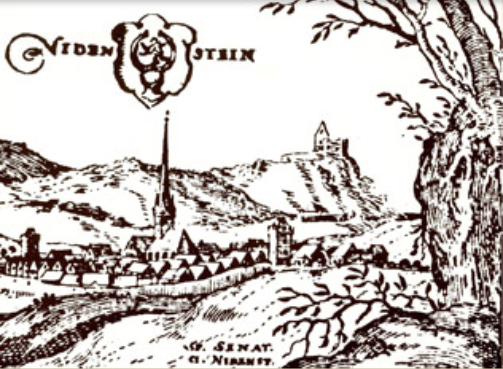Herman and Alexandra had seven children: Alexandra, Constantin (who died as a child at age 3), Helene, Vladimir, Eugen, Marie and Boris. Alexandra, Helena, Wladimir, Eugen and Marie had children.
Boris was born in St. Petersburg in 1878. He was an attorney and after the revolution went to Paris. He married Ekatharina Feodorowna Barth, the grandniece of Admiral Barth. He second wife was Catharina Becker, a Baroness of Nolde.

The following three paragraphs about Boris Knatz were translated for me from a book titled “Who was behind Stalin’s back?” by Alexander V Ostrovsky.
Boris H. Knatz was the son of a St. Petersburg merchant, according to some sources, Spanish, according to other Prussian subjects Herman Karlovich Knatz, a Reformed religion, from his marriage with Alexandra Nikolaevna Levitskaya (TsGIA St. Petersburg. T. 14. Op. 3. 25710. L. 1.5). B. H. Knatz was born on January 10, 1878, in May 1900, externally passed exams for the full course of the law faculty of St. Petersburg University and on August 26 of the same year began serving in the office of the Suwalki governor, the position of which was then held by E. A. Watatsi, but on February 1, 1901 he was dismissed from his post and returned to the capital due to the illness of his father. Here he was first enrolled in the staff of the Ministry of Internal Affairs, then transferred to the Ministry of Agriculture and State Property (RGIA. T. 1284. Op. 52. 1901. 21. L. 1-18), and in 1902 we see him already as an assistant sworn attorney (All Petersburg in 1902, p. 295). B. H. Knatz had two brothers: Vladimir and Eugene. In 1917, Evgeny H. Knatz served as director of the Ludwig Nobel plant (All Petrograd in 1917, S. 319).
On February 28, 1917, the first head of the Petrograd police was appointed architect Dmitry Andreevich Kryzhanovsky, engineer Moses Abramovich Mett became his assistant, and the head of the protection of the Foundry, on the territory of which was the Police Department, sworn attorney Boris H. Knatz
It was B. H. Knatz on March 1 who took protection of the Police Department and was the first to gain access to its archive. acquaintance with the file cabinet of the Police Department also shows that after the fall of the monarchy, she also underwent some cleaning. As an example, we can point to the memoirs of the head of the first revolutionary guard G. H. Knatz, from which it is clear that his surname appeared in this file cabinet , then it disappeared from it.
Here is the Russian excerpt of the first paragraph:

From this text we can surmise that Boris H. Knatz was a revolutionary and was familiar with Stalin. It could be that Boris went to France after the dealth of Lenin as his memories of the revolution were published in an emigrant magazine. There are his memories of the revolution in a magazine that were published in Paris, France from 1926 (Knatz B. G. Occupation of the Police Department. March 1-5, 1917//The voice of the past on the foreign side. 1926. № 6 (19). Page 139-156. ( in the russian language- Кнатц Б. Г. Занятие Департамента полиции. 1–5 марта 1917 // Голос минувшего на чужой стороне. 1926. № 6 (19). С. 139–156. There are his memories of the revolution. I have been unable to find copies of these articles. (If anyone can find them, let me know).
Boris was married twice
The text above confirms the relationship between the Knatz family and the Noble family. Hermann’s son Eugen served as director of the Ludwig Noble plant. Ludwig Nobel was the older brother of Alfred Nobel who founded the Noble prize. Ludwig Noble was the wealthiest of the Noble brothers and at one time was one of the richest men in the world, mainly due to investments in oil. Eugen was born in St. Petersburg on October 19, 1871. He married Catharine Laiming. They had 4 children, Igor, Marie, Helena and Catarina. Marie was born in 1906.I got the impression that Eugen also had wealth as the family had a summer home outside of St. Petersburg and during the Russian Revolution had to flee to Revel, Estonia and lost all they had in Russia. There, Eugen worked as Director of a machine factory. Marie’s son Nikita used his mother’s surname Knatz although his father’s last name was Popov. His father also was artistic. Nikita was born in Tallinn, Estonia in 1940. This was the home that Nikita Knatz traveled back to find in Russia with film director Norman Jewison.
In April, 1947, Eugen’s daughter Catarina, now Catarina (or Katharina) Hohlova, emigrated to Brazil with her two year old son Georg. She considered herself stateless.

Both Boris and Eugene also returned from Russia to visit family in Cassell. The connection to their German family lasted until about WWII ending with Herman’s grandchildren. From this family line, the family scattered and there are traces of them in Moscow, Revel (now known as Tallinn,Estonia), Warsaw, Paris, Vologda and Radebeul by Dresden.
I only had the opportunity to meet Nikita Knatz once before he passed away on January 6, 2010. He told me about his life. He told me during World War II he and his mother and siblings fled from the advancing Russian troops, following the retreat of the German troops on the eastern front. He told me about getting on a Red Cross ship with his mother to cross the Baltic Sea, his Aunt and his siblings were on another Red Cross ship. That ship was torpedoed. Nikita and his mother spent the war years in European refugee camps. Nikita told me he recalled moving around Germany a lot like they were looking for something. Maybe his mother had heard about the Germans Knatz’s. Nikita’s mother was involved in the theatre and had made contact with Russians living in San Francisco. Nikita and his mother immigrated to the US in 1949 and became part of the large Russian community in San Francisco. Nikita took his mother’s last name “Knatz” although his father’s name was “Popov.” Both he and his father had artistic talent. Because he was fluent in Russian, Nikita was cast as one of the Russian sailors in “The Russian’s are Coming, The Russians are Coming” produced and directed by Norman Jewison. Once when Mr. Jewison noticed Nikita doodling on the set, he realized he had an artistic ability and he went on to become a storyboard artist and worked on over 100 films including the Thomas Crown Affair, the Towering Inferno, The French Connection II, Predator, Command, Terminator, Hellboy , the Mummy and the TV Show “Lost.” Nikita worked occasionally as an actor on TV shows like Mission Impossible, The Wild Wild West and Streets of San Francisco.
Nikita considered himself a Cossack and was devoted to the Russian Orthodox Church. Ilse told me he had gone back to St. Petersburg to visit the Knatz ancestral home and there in the barn he found a Rolls Royce with the Knatz crest on it. If only we knew where this was! Nikita was buried at a Russian Orthodox Monastery in New York State.


